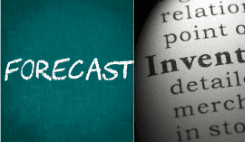07.21.20
 4 Manufacturing Demand Forecasting Methods">
4 Manufacturing Demand Forecasting Methods">
What's the best manufacturing demand forecasting methodology for you?
As a manufacturing business, you know that forecasting your inventory stock levels is a challenge. It’s a constantly moving target. In the past, you may have spent hours with Excel spreadsheets or relied on your judgment or hunch for inventory management. In the best-case scenario, you’re armed with historical, real-time and future projection data to give you detailed information for improved forecasting accuracy. How can you leverage a modern ERP solution to produce enough to satisfy customer demand while avoiding overstock costs? Let’s explore these 4 forecasting methods to help begin the discovery of what’s best for your operation.
1. Push Systems: garbage in, garbage out
Push-based inventory management seeks to predict the amount of inventory needed during a given period based on demand. From this, the organization derives a production schedule that allocates resources such as staff, parts, and raw materials. Unfortunately, the production plan is only as good as the inputs that go into it, and for most businesses, demand can be extremely hard to predict.
Demand forecasts generally come from two different areas: sales and production. Both of these sources present challenges for the organization seeking to optimize inventory levels.
2. Sales Driven Forecasts
A sales-driven forecast looks at what the sales team expects to close within a given time-frame. This should be derived from the current pipeline of opportunities and an assessment of their likelihood of closing within the period. As many manufacturers know first-hand, the problem with calculating demand based on the sales forecast is that these forecasts are often wrong—sometimes wildly so.
"In many organizations, forecasting is largely a political endeavor," says Tamara Schenk, Research Analyst at CSO Insights, an MHI Global Company. "Salespeople create the forecast based on what is in their pipeline but are heavily influenced by what they know their managers want to see. Their managers then massage the data before passing it on to the next level. At each level, the data gets pushed and pulled until the forecast bears little resemblance to the actual sales funnel."
It’s difficult for production to build forecasting and production plans based on what sales management hopes will happen. Any inventory planning specialist will tell you that intuition doesn't lead to a sound inventory management strategy.
3. Production Driven Forecasts
The alternative approach is to discount sales entirely and rely on production's assessment of what will be needed. This approach relies on year-over-year production requirements and then applies educated guesses at what will be required. The challenge is that production often lacks visibility into the sales funnel and any dynamic changes in market conditions.
Some organizations try to address this problem by holding joint production planning meetings with sales. All too often it reintroduces the political stresses since sales managers are eager to make quota. It’s common for sales to overestimate requirements to ensure they will have enough products on hand to promise a competitive delivery date. When those sales don’t materialize, inventory levels rise.
4. Pull Systems: A lean thinker's dream
Pull-based manufacturing systems take a different approach. They focus on inventory requirements and production based only on what has been sold. Properly implemented, pull-based systems have several benefits including:
As simple as pull-based inventory management sounds, it can be more difficult to get right. When an organization tries to implement a pull-based approach without the proper discipline, planning, and system support, the effects can be devastating.
These forecasting principles are not new--they are just getting smarter with technology developments. Before the current generation of modern ERP systems, many of the most effective techniques had to be implemented manually.
The Clients First Difference
Industry expertise and experience – Clients First consultants have direct experience in the industries we support. The Clients First Texas office is known for its vertical expertise in manufacturing, job shops, and maintenance, repair and overhaul (MRO) for aviation or heavy equipment organizations. We have customers in other industries, too, including make-to-order/engineering job shops, project manufacturing, field services, and wholesale distribution.
We’re a Microsoft Gold ERP Partner, a Certified Cloud Service Provider (CSP), and an Acumatica Gold Partner.
Please contact us for a free evaluation of your current manufacturing operation. If it’s a good fit, we’ll work with you on a plan to implement Dynamics 365 Finance and Supply Chain or Dynamics Business Central to improve your bottom line.
Contact Us: Email: Dallas/Fort Worth, Texas, or call us at 800.331.8382. We're located in Dallas, Texas and service companies worldwide.
Our team brings unmatched efficiency and value for a smooth implementation and beyond. Find out how we can help your business gain a competitive advantage in the marketplace.
Free Consultation